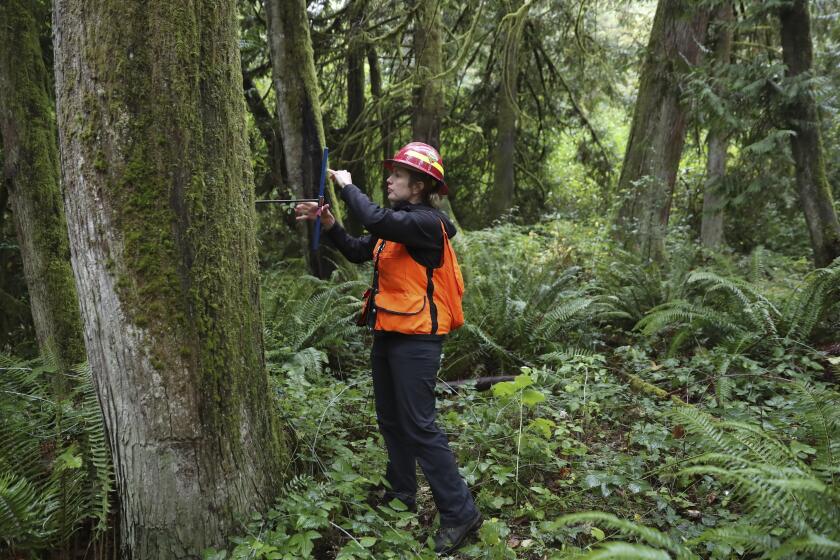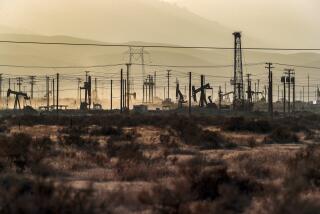‘Little ray of hope’: Carbon hot spots discovered near California coast

- Share via
Scientists exploring the Northern California Coast have, for the first time, uncovered a treasure trove of carbon compacted on the seafloor — a discovery that may help unravel the ocean’s power to combat climate change.
A reserve spanning 6,000 square miles of sanctuary from Point Arena in Mendocino County south to Point Año Nuevo in San Mateo County stores 9 million metric tons of carbon on the surface of the seafloor, according to a study released by the National Oceanic and Atmospheric Administration’s Office of National Marine Sanctuaries.
The amount of carbon found sitting on the seafloor’s first four inches equates to the CO2 emissions generated by 7.3 million gas-powered vehicles driven for one year or expended to power 6.4 million homes for a year, according to the Environmental Protection Agencies’ greenhouse gas equivalencies calculator.
Researchers stressed that while this is a significant discovery, leaving it undisturbed is crucial in allowing further carbon accumulation.
“This isn’t a resource to be utilized, but it’s to be kept intact,” said Doug George, an ocean scientist at NOAA and the study’s co-author.
The findings confirm that the ocean becomes the final resting place for greenery and dead wildlife washed from rivers, as well as marine life that dies and sinks to the seafloor. That results in more carbon being locked away in the oceans, which helps correct the CO2 imbalance in the atmosphere, according to the study.
Iconic red cedars, known as the “Tree of Life,” and other tree species in the Pacific Northwest have been dying due to climate-induced drought, researchers say.
The study’s lead author, Sara Hutto, explained that Earth has a set amount of carbon. Since the Industrial Revolution, humans have dug up massive amounts of fossil fuels that took millenniums to form underground. By doing so, carbon is taken out of the planet and burned, releasing carbon dioxide into the atmosphere and changing the carbon-to-carbon-dioxide balance.
“We want to make sure that we are not contributing to the climate problem but that we are doing everything we can to enhance the ocean’s natural sponge-like ability to absorb carbon dioxide,” Hutto said in an interview.
She believes her team’s study proves the ocean cannot be ignored when discussing climate solutions. She said the sea is vital, given its ability to hold most of the world’s carbon, absorb the heat created by emissions, and produce one-third of the world’s oxygen.
“The ocean is a victim of climate change, but it’s also one of the many solutions we need to focus on to get ourselves out of this mess,” Hutto said.
Several years ago, Hutto and her team set out to better understand the role of what experts call “blue carbon” processing plays in addressing climate change, the first study of its kind in the U.S. “Blue carbon” refers to the carbon captured and stored by marine and coastal ecosystems.
Researchers sifted through data samples of seafloor sediment in protected waters dating back to the 1950s, mapping carbon hot spots. The report showed significant amounts of carbon, particularly in muddy deltas where the river and ocean connect.
Months after storms buried communities in the San Bernardino Mountains, recovery is ongoing. But with a new winter approaching, worry is spreading about a strong El Niño.
Although the study into carbon hot spots is limited to Northern California, the finding prompts speculation from researchers about the potential abundance of carbon stored in sediment-rich regions, like the Gulf Coast, influenced by the runoff from the Mississippi Delta.
“The Gulf Coast is a very muddy place, so understanding that all that mud might be trapping a lot of organic carbon is a valuable component of understanding how the ocean stabilizes our climate,” George said.
Hutto highlighted that scientists have just recently initiated a deeper exploration of seabed carbon, and researching seabed carbon within potential sanctuaries could lead to formulating regulations for safeguarding the seafloor’s ecosystem.
Hutto’s team says blue carbon is often overlooked in climate mitigation policies because the science behind it is in its infancy and because nature-based solutions to climate change are much messier and less straightforward than technology-derived solutions.
“This information offers a little ray of hope that the ocean is playing this really vital role for us, and maybe we’re underappreciating it, and there are opportunities to protect that role,” Hutto said.
While the discovery may lead some to suggest that the newly found carbon is ripe for extraction, Hutto, said the carbon-rich mud is only surface-level and is useless for burning the way that deeper level fossil fuels are because it hasn’t been compacted enough over time like large fossil fuel reservoirs.
As long as the carbon is untouched, it is stable, but if stirred up, there’s potential for it to react with oxygen, resurface, and interact with the atmosphere, causing a CO2 emissions issue.
More to Read
Sign up for Essential California
The most important California stories and recommendations in your inbox every morning.
You may occasionally receive promotional content from the Los Angeles Times.













